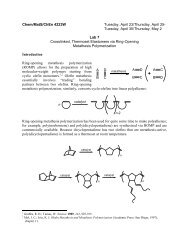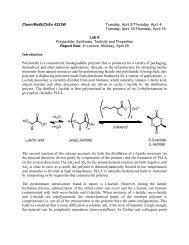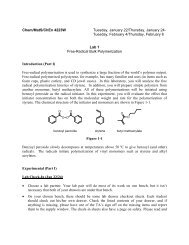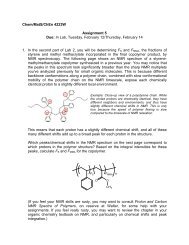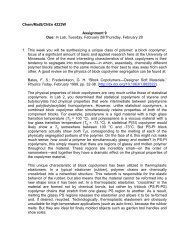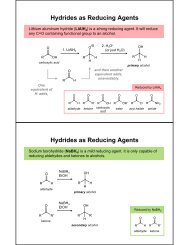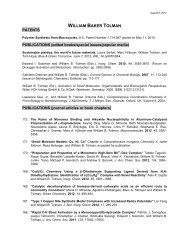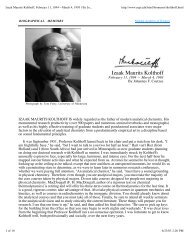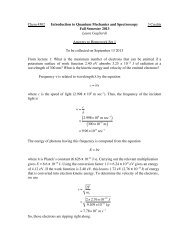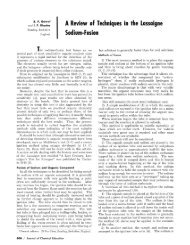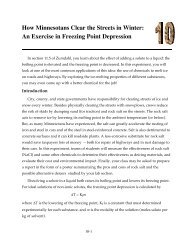Inverse Opal Photonic Crystals - Department of Chemistry ...
Inverse Opal Photonic Crystals - Department of Chemistry ...
Inverse Opal Photonic Crystals - Department of Chemistry ...
You also want an ePaper? Increase the reach of your titles
YUMPU automatically turns print PDFs into web optimized ePapers that Google loves.
Figure 14. Photograph <strong>of</strong> the three sizes <strong>of</strong> inverse opal<br />
silica powder held between glass microscope slides, observed<br />
in reflected light. The small, medium and large<br />
pore inverse opal silica samples appear blue-violet,<br />
green, and orange-pink, respectively, due to diffraction<br />
<strong>of</strong> light <strong>of</strong> successively longer wavelengths.<br />
Small Medium Large<br />
It is important to note that the color <strong>of</strong> photonic crystals depends entirely on diffraction, and is<br />
independent <strong>of</strong> electronic processes. Most other colorful materials derive their color by the<br />
absorption <strong>of</strong> visible light, which causes electronic transitions that give <strong>of</strong>f colors. When a<br />
substance absorbs certain wavelengths <strong>of</strong> visible light, its color is determined by the wavelengths<br />
<strong>of</strong> visible light that remain. The substance exhibits the color that it reflects, which is<br />
complementary to the color <strong>of</strong> light that it absorbs. Silica appears white because it does not<br />
absorb any light wavelengths in the visible region. Silica inverse opals, on the other hand,<br />
appear colored – not due to absorption <strong>of</strong> light, but instead due to diffraction <strong>of</strong> light from the<br />
periodic arrangement <strong>of</strong> the uniformly sized pores. An important consequence <strong>of</strong> this difference<br />
in the origin <strong>of</strong> color is our ability to observe two components <strong>of</strong> the light instead <strong>of</strong> one. As<br />
with other colored substances, we can see the light that an inverse opal reflects. But, unlike other<br />
colored substances, the inverse opal does not absorb the complementary color; this color is<br />
instead transmitted through the inverse opal (Figure 15).<br />
These optical properties can easily be<br />
observed in your inverse opal material by<br />
holding the sample against a dark surface to<br />
see the reflected color, and holding it up to<br />
the light to see the complementary<br />
transmitted color. The colors may not be<br />
very prominent if the lab room has very<br />
bright lights, so try dimming the lights and<br />
using a flashlight as a light source if you<br />
have difficulty seeing these optical effects.<br />
Figure 16 illustrates photographs <strong>of</strong> how the<br />
medium pore inverse opal silica sample<br />
should appear in orientations with the observer<br />
and light source on the same side and<br />
on opposite sides <strong>of</strong> the inverse opal.<br />
You’ll notice that the sample looks green<br />
when light is reflected from its surface, and<br />
pink when light is transmitted through it.<br />
Figure 15. Observed behavior <strong>of</strong> the interaction <strong>of</strong> white<br />
light (which contains all visible wavelengths) with inverse<br />
opal photonic crystals. When white light strikes the sample,<br />
it is separated into two components: light <strong>of</strong> one color is<br />
reflected from the surface <strong>of</strong> the inverse opal, while light <strong>of</strong><br />
the complementary color is transmitted through the inverse<br />
opal.<br />
Samples with different pore sizes will exhibit a similar complementary relationship between the<br />
transmitted and reflected colors. If your lab has a microscope, put a small amount <strong>of</strong> inverse<br />
25



